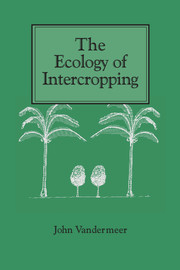Book contents
- Frontmatter
- Contents
- Preface
- 1 Introduction: intercrops and ecology
- 2 The measurement of intercrop performance
- 3 The competitive production principle
- 4 Facilitation
- 5 Mechanisms of the competitive production principle
- 6 The environments modified to produce facilitation
- 7 Special problems in intercrops involving perennials
- 8 Weeds and intercrops
- 9 Variability and intercrops
- 10 Planning intercrops – a phenomenological approach
- 11 Planning intercrops – a mechanistic approach
- 12 Critical research directions for the future
- References
- Author index
- Subject index
3 - The competitive production principle
Published online by Cambridge University Press: 05 August 2012
- Frontmatter
- Contents
- Preface
- 1 Introduction: intercrops and ecology
- 2 The measurement of intercrop performance
- 3 The competitive production principle
- 4 Facilitation
- 5 Mechanisms of the competitive production principle
- 6 The environments modified to produce facilitation
- 7 Special problems in intercrops involving perennials
- 8 Weeds and intercrops
- 9 Variability and intercrops
- 10 Planning intercrops – a phenomenological approach
- 11 Planning intercrops – a mechanistic approach
- 12 Critical research directions for the future
- References
- Author index
- Subject index
Summary
The basic idea
We begin our exploration of the mechanisms of intercrop advantage by pointing out that one potential mechanism is, in a sense, no mechanism at all. While casual observation leads us to question what causes particular patterns, it is sometimes worthwhile to reflect and ask if the patterns perhaps occur because nothing much is happening. It turns out, as described below, that because of the way we define intercrop advantage, it is quite possible, even perhaps common, to observe an intercrop advantage without anything special happening.
It is easiest to understand this ‘mechanism’ by referring to a similar phenomenon, recognized for many years, in community ecology. It is generally accepted (although the details remain hotly debated) that when two species do similar things (i.e. occupy the same niche, interfere with each other's activities, compete with one another, etc.) it is unlikely that there is enough room in the environment for both. Loosely, two species cannot occupy the same niche. If their niche requirements are sufficiently similar, which is to say they compete with one another intensely, one or the other will become extinct, given a long enough time. On the other hand – and this point is often not emphasized sufficiently – if the two species have similar but distinct requirements, which is to say they compete with one another only weakly, they may both persist indefinitely in the environment.
- Type
- Chapter
- Information
- The Ecology of Intercropping , pp. 29 - 45Publisher: Cambridge University PressPrint publication year: 1989
- 2
- Cited by



